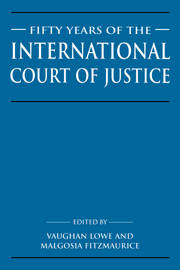Book contents
- Frontmatter
- Contents
- List of contributors
- Preface
- List of abbreviations
- Sir Robert Yewdall Jennings, by Vaughan Lowe
- List of publications of Sir Robert Jennings
- Table of cases
- Part I The International Court of Justice
- Part II The sources and evidences of international law
- Part III Substance of international law
- Part IV Procedural aspects of the work of the International Court of Justice
- 21 Procedural law and the International Court of Justice
- 22 The President of the International Court of Justice
- 23 Nationality of claims: some relevant concepts
- 24 The plea of domestic jurisdiction before the International Court of Justice: substance or procedure?
- 25 ‘Partial’ judgments and the inherent jurisdiction of the International Court of Justice
- 26 Intervention before the International Court of Justice
- 27 The use of Chambers of the International Court of Justice
- 28 The use of experts by the International Court of Justice
- 29 Provisional measures
- 30 Remedies in the International Court of Justice
- 31 A comment on the current health of Advisory Opinions
- Part V The International Court of Justice and the United Nations
- Index
22 - The President of the International Court of Justice
Published online by Cambridge University Press: 02 November 2009
- Frontmatter
- Contents
- List of contributors
- Preface
- List of abbreviations
- Sir Robert Yewdall Jennings, by Vaughan Lowe
- List of publications of Sir Robert Jennings
- Table of cases
- Part I The International Court of Justice
- Part II The sources and evidences of international law
- Part III Substance of international law
- Part IV Procedural aspects of the work of the International Court of Justice
- 21 Procedural law and the International Court of Justice
- 22 The President of the International Court of Justice
- 23 Nationality of claims: some relevant concepts
- 24 The plea of domestic jurisdiction before the International Court of Justice: substance or procedure?
- 25 ‘Partial’ judgments and the inherent jurisdiction of the International Court of Justice
- 26 Intervention before the International Court of Justice
- 27 The use of Chambers of the International Court of Justice
- 28 The use of experts by the International Court of Justice
- 29 Provisional measures
- 30 Remedies in the International Court of Justice
- 31 A comment on the current health of Advisory Opinions
- Part V The International Court of Justice and the United Nations
- Index
Summary
Like all collegiate organs, the International Court of Justice is headed by a President. In current practice, there are two patterns for the presidency of collegiate international organs. In most ‘large’ organs composed of states, such as the General Assembly of the United Nations or a major plenipotentiary conference, the President is normally a member of a delegation from which, however, the Rules of Procedure will exclude him. In ‘small’ bodies, including for this purpose the Security Council (composed of the representatives of states) or the International Law Commission (composed of individuals), the presiding officer is chosen according to the stipulations of the constituent instrument (including the Rules of Procedure), but remains a full member of his delegation or a full participant in the body to which he belongs, retaining his right to vote. In those circumstances, it is customary for the presiding officer to speak last: voting is usually, in this type of organ (but not in the International Court), conducted instantaneously, and today frequently through electronic means. The President of the International Court belongs to this second category.
Article 21 of the Statute requires the Court to elect its President and Vice-President for three years; they may be re-elected.
- Type
- Chapter
- Information
- Fifty Years of the International Court of JusticeEssays in Honour of Sir Robert Jennings, pp. 406 - 423Publisher: Cambridge University PressPrint publication year: 1996
- 4
- Cited by

